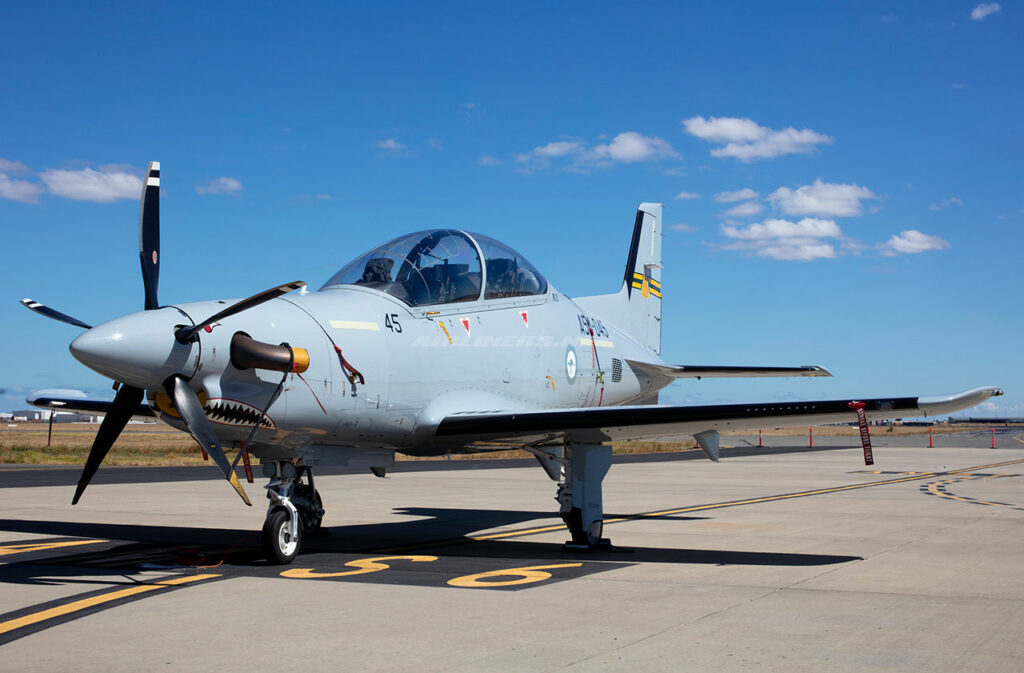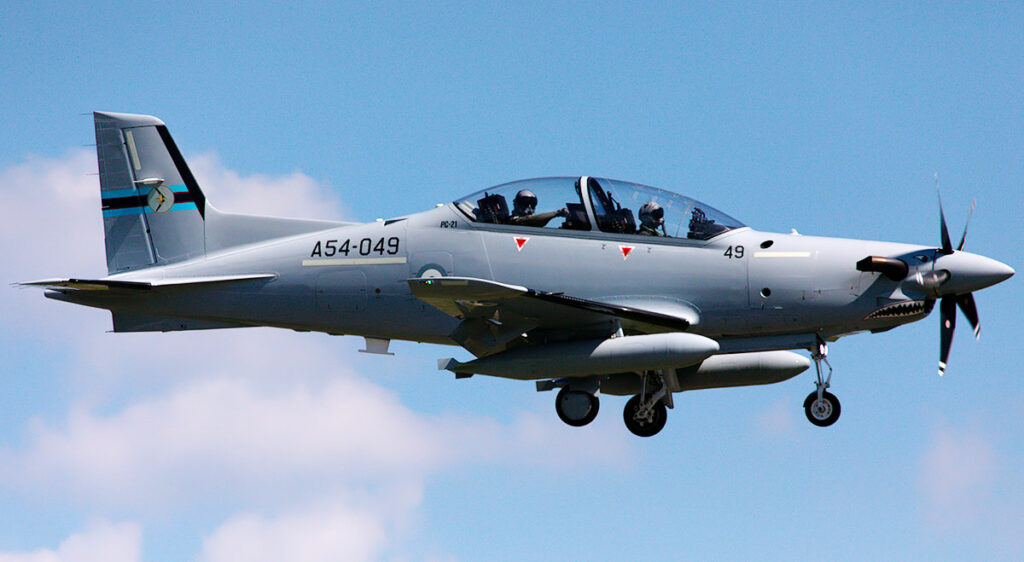Pilatus PC-21: advanced turboprop trainer, equipped with state-of-the-art avionics, designed for fighter pilot training.
In brief
The Pilatus PC-21 is an advanced turboprop trainer aircraft designed for comprehensive pilot training. Equipped with the Pratt & Whitney PT6A-68B engine, it produces 1,600 shp, achieving a top speed of 370 knots (685 km/h) and a maximum altitude of 25,000 feet (7,620 meters). Its fully digital cockpit includes glass displays, hands-on throttle and stick (HOTAS) controls, and integrated head-up displays, replicating modern fighter jets. This advanced avionics system allows trainee pilots to familiarize themselves with the complexity of jet operation at a reduced cost. The PC-21 can simulate various training missions, including air-to-air and air-to-ground radar operations, enhancing pilot preparation. Operational since 2002, the aircraft’s design prioritizes maneuverability with a high wing loading and provides cost-effective training solutions, replacing older jet trainers in many air forces around the world.

The Pilatus PC-21
The Pilatus PC-21 was developed in response to a growing demand for an advanced turboprop trainer capable of preparing pilots for modern fighter aircraft. By the late 1990s, the need for efficient and cost-effective training solutions became evident, as many air forces sought to replace outdated trainers. Pilatus Aircraft Ltd, renowned for their series of trainer aircraft, initiated the PC-21 project in 1999, aiming to deliver an aircraft that could bridge the gap between basic training and advanced fighter pilot training.
The PC-21 took its maiden flight on July 1, 2002, showcasing innovative features such as a high-performance engine, cutting-edge avionics, and a comprehensive training suite. Although it does not have a NATO nickname, the PC-21 has become widely recognized in military aviation circles. The aircraft’s advanced simulation capabilities allow for the emulation of combat scenarios, offering students hands-on experience with systems found in frontline combat jets. Its adoption by numerous air forces worldwide underscores its effectiveness and versatility as a training platform.
History of the Development of the Pilatus PC-21
In the late 1990s, as air forces around the world faced increasing costs associated with maintaining and operating jet trainers, Pilatus Aircraft Ltd identified a need for a more efficient solution. Their answer was the PC-21, a turboprop trainer capable of replicating jet performance and preparing pilots for the demands of modern fighter aircraft. The development program for the PC-21 officially launched in January 1999, with a vision of creating a robust training platform that could handle basic, advanced, and lead-in fighter training.
The PC-21, building on the legacy of Pilatus’ earlier trainers like the PC-7 and PC-9, aimed to reduce training time and costs. Designed as a jet alternative, the PC-21 incorporates advanced avionics, simulation systems, and high-speed performance typically associated with jets. The maiden flight in 2002 marked the PC-21’s transition from concept to reality, with Swiss precision engineering at its core. Unlike traditional trainers, the PC-21’s embedded training systems allow students to simulate radar operations, air combat, and weapons deployment without the expense of a jet engine.
Following its introduction, the PC-21 was quickly adopted by the Swiss Air Force, which sought an efficient training aircraft that could emulate the experience of flying advanced fighters. Over the next decade, several air forces, including those of Singapore, Australia, and the UAE, added the PC-21 to their fleets, appreciating its unique combination of turboprop efficiency and jet-like performance capabilities. With over 200 units delivered globally, the PC-21 has redefined training standards and continues to support modern air forces in achieving mission readiness.
Design of the Pilatus PC-21
The PC-21 is a low-wing, tandem-seat trainer aircraft designed to simulate the operational environment of modern jet fighters. Its construction includes an aluminum primary structure with composite materials to enhance durability and reduce weight. The aircraft spans 29.9 feet (9.1 meters) with a length of 36.8 feet (11.2 meters) and a height of 12.3 feet (3.8 meters). The PC-21’s wings are optimized for higher speeds, incorporating sweepback and winglets to reduce drag and improve handling.
The cockpit features a fully digital glass system with color displays and HUDs for both the student and instructor, mirroring those in current frontline fighters. This setup enables realistic training scenarios, including simulated air combat. Its HOTAS configuration allows pilots to control most systems without removing their hands from the throttle or stick, a feature found in many operational fighter jets. One unique aspect of the PC-21 is the decoupling of the forward and rear cockpits, enabling instructors to simulate faults or adjust training parameters in real time.
The PC-21’s five-blade graphite propeller is powered by a PT6A-68B engine, delivering a maximum power output of 1,600 shp. This setup allows for impressive agility and provides the high-speed performance necessary for fighter lead-in training. However, the turboprop configuration limits its altitude and speed compared to jet trainers, though it compensates with fuel efficiency and lower operating costs. While the PC-21 lacks the afterburners and supersonic capabilities of a jet, it delivers adequate performance for initial training phases.
Performance of the Pilatus PC-21
The Pilatus PC-21’s powertrain includes a Pratt & Whitney PT6A-68B engine that provides up to 1,600 shp. With a top speed of 370 knots (685 km/h) and a service ceiling of 25,000 feet (7,620 meters), the PC-21 is one of the fastest turboprop trainers available. It also has a maximum range of 1,300 nautical miles (2,408 kilometers) with internal fuel tanks. The aircraft can sustain high-G maneuvers, with a structural limit of +8/-4 g, which is vital for replicating the conditions of fighter aircraft.
Compared to other trainers, such as the Beechcraft T-6 Texan II, the PC-21 offers superior speed and climb rates, achieving 4,000 feet per minute (1,219 meters per minute). Its endurance and efficiency make it a practical choice for extended training missions. The advanced avionics suite, which includes a mission computer and tactical data link, allows the PC-21 to handle complex training exercises that prepare pilots for sophisticated multi-role fighters.
In contrast, the T-6 Texan II reaches only around 316 knots (585 km/h) and has a lower maximum ceiling. The PC-21’s higher wing loading, a design feature typical of jets, enhances its stability at higher speeds, making it more suitable for air combat training. This feature, along with the advanced simulation capabilities, gives the PC-21 a distinct edge in comprehensive pilot training.
Variants of the Pilatus PC-21
The PC-21 comes in several configurations, tailored to meet the needs of different air forces. While the base model is standardized, Pilatus offers customization options in avionics and training systems.
For example, the PC-21 used by the Royal Australian Air Force includes tailored cockpit displays and systems to meet specific training requirements. Another variant is the Swiss Air Force model, which includes adaptations for operating in mountainous regions. In general, the aircraft can be outfitted with additional instrumentation, communication systems, and cockpit controls, making it adaptable for a range of training missions.
Each PC-21 variant is compatible with ground-based simulation tools, allowing air forces to enhance training efficiency and reduce flight hours needed for pilot qualification. Despite these differences, all PC-21s share the same fundamental design, focusing on replicating the handling characteristics of modern fighters while keeping operational costs low.

Military Use and Combat of the Pilatus PC-21
While the Pilatus PC-21 is not designed as a frontline combat aircraft, its training capabilities have allowed various air forces to use it for limited combat simulation roles. With support for weapons emulation, including radar and tactical data systems, the PC-21 can replicate many combat scenarios, such as air-to-air and air-to-ground engagements. This capability makes the PC-21 an invaluable asset in pilot training, especially for countries that rely on it as a precursor to fighter jets like the F-16 or Eurofighter Typhoon.
For instance, the UAE and Saudi Arabian air forces employ the PC-21 to prepare pilots for these fighters, using the PC-21’s simulation systems to practice radar and electronic warfare techniques. Additionally, Singapore uses the PC-21 to conduct comprehensive air combat training, replacing older jet trainers with this more versatile turboprop model.
The PC-21 remains in active service with air forces in Switzerland, France, and Spain, among others. Notably, the Spanish Air Force has integrated the PC-21 to replace its aging fleet of Casa C-101 jet trainers, highlighting its ability to substitute for jets in advanced pilot training. Despite its non-combat role, the PC-21 provides extensive tactical training at a fraction of the cost, making it a valuable part of military aviation programs worldwide.
Back to the Trainers section.